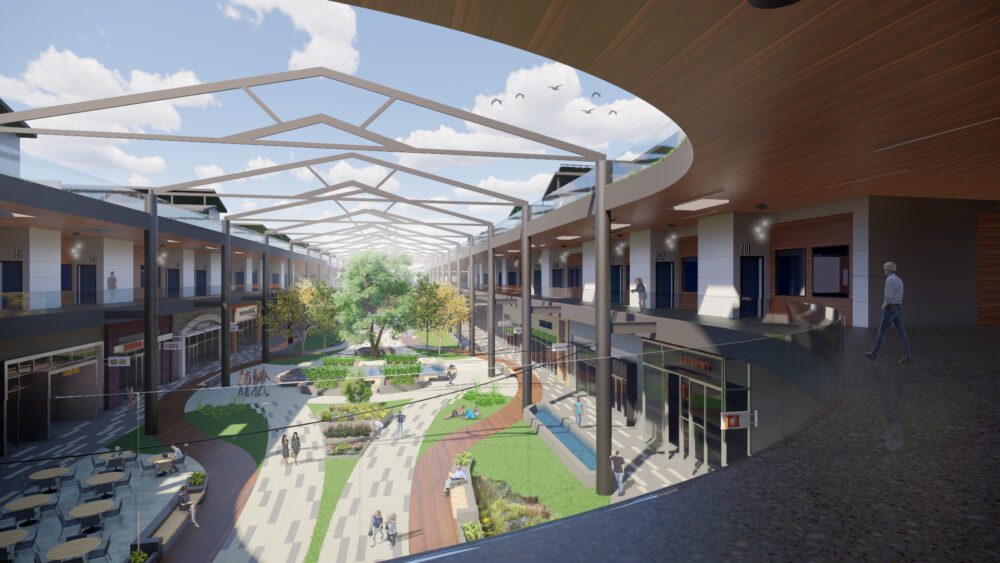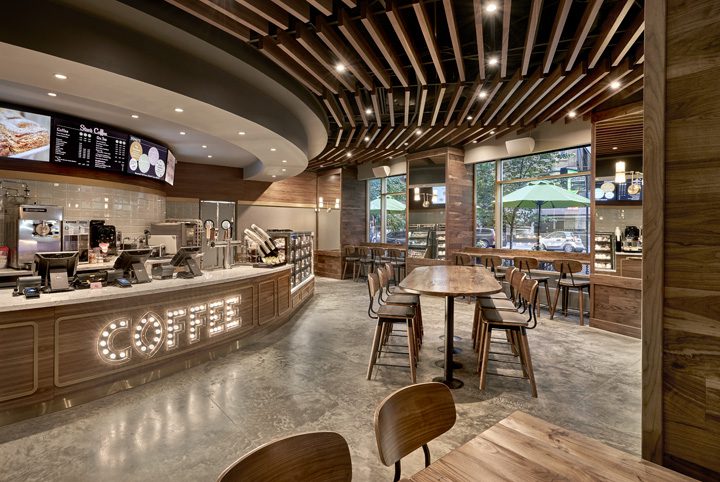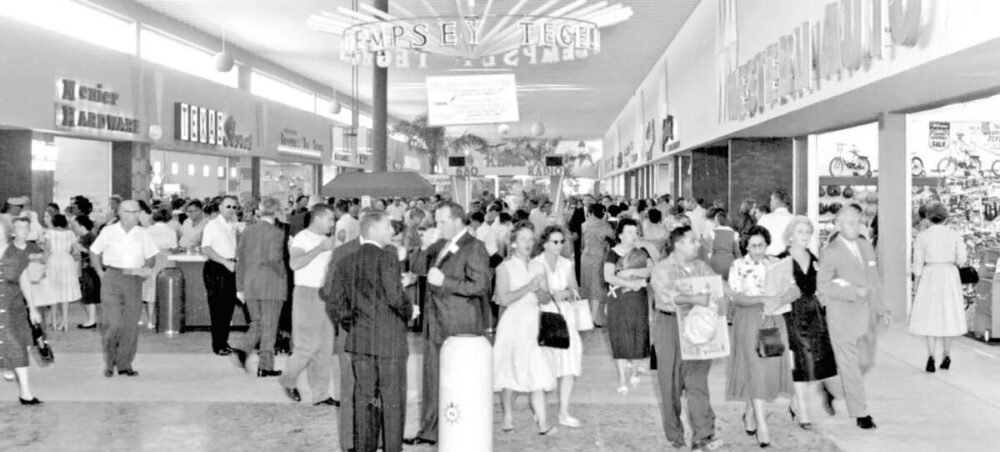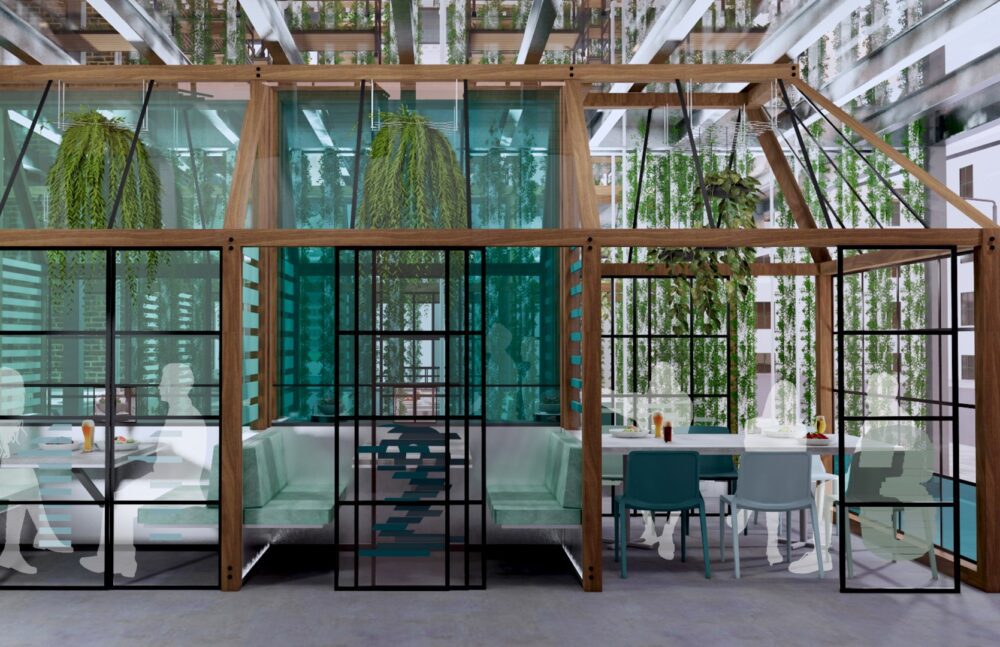
 Interior Courtyard Redevelopment Rendering
Interior Courtyard Redevelopment Rendering
While modern society looks towards the next shiny and new place to be, we often neglect to address our current spaces and how we use them. In an ever-expanding online world, shopping malls have taken a hit. With the effect of the pandemic this past year, the result has meant closures of many retailers. Our team explored concepts for redevelopment of a local mall that has seen better days.
 Current Charlestowne Mall, St. Charles, IL images (Google Images/Flickr)
Current Charlestowne Mall, St. Charles, IL images (Google Images/Flickr)
Charlestowne Mall sits in a well-trafficked, highly visible location in St. Charles, about an hour west of Chicago. But with the decline of retail and use of these spaces, there are ways to leverage current infrastructure that can revive malls like Charlestowne for the better. This design concept addresses the many challenges facing Charlestowne mall and similar suburban shopping centers. Opportunity in the scale and framework of these developments can foster an adaptive reuse approach and provide new ideas for living and working.
The initial idea absolves the single-use of Charlestowne mall by introducing living units and places to work, along with the traditional shopping/entertainment aspects. The design prioritizes greenspace and open air courtyards to both connect the development to the surrounding area and provide ample public and semi-public space.
 Mall Entry / Farmer’s Market above ground-level parking
Mall Entry / Farmer’s Market above ground-level parking
The project has re-organized the former mall into various functions, taking advantage of the multi-level layout with ample atrium/courtyard space. The lower level remains commercial, yet it introduces the idea of more office, work, and creative space to create a sense of community. Similar to malls today, there is an advantage in a large property containing theaters, amphitheaters, and other community based functions. Surrounding the structure is an expansive greenspace that resides over the top of the parking lot(s). The greenspace was envisioned as a way to connect the users of the mall with the outside community while also providing a location for playgrounds, gardens, and even a farmer’s market.
 Natural light fills the space from the front atrium-facing windows, the back patio, and from the light well at the terrace above.
Natural light fills the space from the front atrium-facing windows, the back patio, and from the light well at the terrace above.
Residential units occupy the second floor, giving privacy and a connection to the public functions below. This utilizes the vast roof space, and creates a second residential story that pops up onto the former roof level for many of the units. These dynamic floor plans enhance the livability, increase real estate value, and give the residents a more private ‘yard’ space which would have otherwise been missing in a more urban development. The change to this terrace level also supports passive building strategies like solar and ventilation, reducing the reliance on active systems.
There is opportunity for the residential units to capture the sweet spot between urban and suburban living, which is rapidly gaining popularity and investment in recent years. The spacious, open concepts leverage the high ceilings of the former retail space and allow more flexibility than cramped urban condos, but still benefit from the direct connection to the amenities and community functions within the same development.
 Private Rooftop ‘Yard’ space for residents
Private Rooftop ‘Yard’ space for residents
There is value in looking beyond what shopping malls can be. Through inserting more varied functions such as housing, work/office, and community spaces, they can be revitalized in ways that take full advantage of the existing framework but also address current needs. In the case of Charlestowne and many others, these opportunities already exist. What currently sits with ample unused space can attract new residents and businesses, and more visitors to the new community and destinations as well.
Stan’s: Where Donut & Coffee Lovers Meet
Stan’s Donuts Receives 2020 RD+D Award – Best New Prototype Runner-Up
The annual RD+D Magazine Awards honor the best in restaurant design across seven categories. We are thrilled to announce that Stan’s Donuts & Coffee has been recognized in the Best New Prototype Category – Runner-Up. Check out the RD+D March/April 2021 issue here!
A Historic Chicago Donut Moment
The first Stan’s Donuts was introduced to Chicago in 2014 after a friendship and partnership formed between Rich Labriola (of Labriola Baking Company) and Stan Berman (founder of the iconic Los Angeles donut shop that bears his name). Today, there are multiple locations of Stan’s Donuts & Coffee in the Chicagoland area that serve a vast array of freshly made donuts, delicious coffee, and whimsical experiences to a devoted community of donut lovers.
Where Donut & Coffee Lovers Meet
The client’s vision was to create a space where donut and coffee lovers unite in a comfortable atmosphere. His goal was to turn Stan’s Donuts into an enjoyable place to work or relax. The design team successfully achieved this goal by planning the space with a variety of flexible dining and counter height seats and an abundance of power outlets. A curved corner booth in Stan’s signature bubblegum pink color was designed for customers to cozy up, and has since turned into an iconic Instagram moment.
“I chose Aria for their attention to creativity and knowledge of how the restaurant business works. The design has to be able to be operable in an efficient and profitable manner. We achieved a great, usable design.” – Rich Labriola
Classy Chic Rebrand
The Stan’s Donuts & Coffee prototype design is as irresistible as their donuts and coffee. The atmosphere is chic, spacious, and refined. The design team maintained key branding elements including the bubblegum pink and sage green accent colors, the classic KitchenAid mixer wall display, and “COFFEE” marquee light. On the ceiling, walnut wood baffles radiate from the curved soffit along the front counter. Natural light pours through the wall-to-wall windows and spills onto the tabletops, dining chairs, counter seats, and plush lounge chairs – enticing customers to find their perfect spot. The walnut wood columns and marble front counter add a heightened level of elegance. Faux leather wallcovering is applied to the walls creating an air of maturity and retro ornamentation is reflected through brass details and individually lit cubbies. Overall, a variety of customer needs are met through the design and their sweet tooth is satisfied!
The Team
Our team for this project consisted of Frank Cavanaugh, Principal; Lillian Reyes-Brahar, Project Manager; Travis Vannoy, Project Coordinator; Trina Alsip, Senior Designer; and Arthur Ostrowki, Architectural Technician.
General Contractor: Kern Konstruction
Millworker: Studio Zoran
Custom Finishes: Paul Punke
Photographer: Tony Soluri
Reinventing the American Mall
 North Star Mall Opening Day 1960 (Express News Archives)
North Star Mall Opening Day 1960 (Express News Archives)
Take a drive down the business highway in most mid-size towns, and odds are that you will inevitably pass by one of the great relics of a bygone era in American culture. The indoor mall was once the epicenter of shopping convenience and consumer capitalism in the 70’s, 80’s, and 90’s. Check out this video of the Richfield Edina shopping mall from 1956 — a flashback to this era and one of the earliest malls in the United States. Southdale 1956 – Richfield Edina Shopping Mall
Today many indoor malls are in a state of suspended animation – a gawky, mammoth lying dormant as the pulse of shopping has run back to main street, lifestyle centers, and of course online retail. Many of the flagship brands that iconized the mall era have long since flown the coop for more lucrative pastures, and the bare bones of what remains – empty shops, food courts, theatres, arcades, plazas, and stalls – sit idly awaiting reinvention.
 Photos of Mall exteriors (Abandoned Mall photos – Seph Lawless/Getty Images)
Photos of Mall exteriors (Abandoned Mall photos – Seph Lawless/Getty Images)
It doesn’t take too much digging to unearth why: simply put, the existing mall format does not meet the more holistic needs of today’s generation. This may be most notable when one compares the typical mall configuration, which relies almost entirely on the foot traffic generated by big-box stores, to the rising trend for more integrated lifestyle design, particularly the “live, work, shop, play” format. When you lump in the growing desire for walkability and sustainable urban design, it becomes very easy to scrutinize the visual, and often visceral, reaction that malls evoke; the far out, windowless behemoth sized complexes, which often float in a sea of parking lots, turn customers away through its lack of appeal and accommodation. In short, if indoor malls want to continue to be relevant, they must confront the changing epoch in front of them and seriously commit to an identity make over.
The paradox is that malls are well-practiced in reinventing themselves. New stores, kiosks, seasonal displays, and even small fast-food retailers flip in and out of plug-and-fill spaces all the time. This highlights one of the great silver-linings for malls looking to adapt: the archetype of mall spaces makes them extremely changeable by design. The more demanding work lies in integrating atypical programs to the standard mall framework, such as housing, entertainment, and recreation. At such a large scale, the role of the designers and architects in this realm cannot be understated; planners and developers must become skilled alchemists who balance the correct blend of programs and utilities to address the morphing needs of future dwellers and patrons, while also keeping costs and existing programs in check.
 Case Study: Stratford Square Mall + Aria Group
Case Study: Stratford Square Mall + Aria Group
At Aria Group, our team approached this endeavor by applying our knowledge and long standing history of experiential design and thinking about how we can alter the framework of malls to meet the needs of today. In particular, our team developed a number of proposed interventions for the Stratford Square Mall in Bloomingdale, IL, which like many malls has shared in the saga of continual decline in recent years. Regarding the strategy for revitalization, Principal Frank Cavanaugh wrote, “ the key strategy we see in giving new life to malls is turning them inside out. Carving out and demolishing underutilized gross leasable area (GLA) to create more elevated exterior tenant visibility and enhanced guest experiences”.
 Proposed Plan Concept- Southwest Entry, Stratford Square Mall
Proposed Plan Concept- Southwest Entry, Stratford Square Mall
This includes introducing lively restaurant concepts that perforate the building’s envelope, especially where they might enrichen existing mall entrances, and adding a mix of other lifestyle businesses like spas, health clubs, grocers, and medical offices. Similarly, exterior spaces and parking lots can be converted to event lawns, seasonal skating rinks, beer gardens, and other mixable entertainment spaces to bring more meaningful and attractive entertainment to the surface of the mall.
 Stratford Square Mall Southwest Entry – Before & After
Stratford Square Mall Southwest Entry – Before & After
The mission to diversify the mall’s retail base goes beyond just a facelift however. The proposition also includes the potential to infuse multi-unit residential and office spaces into the existing complex, turning the typical weekend shopping center into a vibrant community of workers and neighbors. This contemporary pairing of program is akin to the complexion of the traditional town center, where shopping is just an element in the macro-experience of everyday life. In fact, it is precisely the varied assortment of experiences that we believe will make Stratford Square such a desirable place to live, and bring patrons back to visit time and time again.
 Stratford Square Mall – Medical & Residential Site Plan Studies
Stratford Square Mall – Medical & Residential Site Plan Studies
To investigate the potential design possibilities in more depth, Aria Group also conducted a case study of a revival of the Charlestown Mall in St. Charles, Illinois. Check out our next post where we share our exploration into the merger of programs and the spatial opportunities that could re-define the future of America’s malls.
Quarantine 2020 Wrapped
 It is crazy to think it’s been over a year since the pandemic began and almost a year since our office started working remote. So much has happened. It has been the longest year, but also feels like it has flown by. As we dive into this new year and look forward to getting back to normal thanks to the vaccine, we asked our team to take a look back. They shared what they discovered about themselves while working remote, what they cooked, and, most important, what they watched on TV while stuck indoors! We all learned so much about ourselves and spent quality time with our families and close friends (if in our quarantine bubble) — many of us really slowed down and spent our time very differently than in years past. We are very much looking forward to what 2021 brings and finally getting to enjoy dinner indoors at a restaurant — with our coworkers and clients. Hope to see you soon and give you a big hug rather than just a mental hug! Check out more of what our team said here.
It is crazy to think it’s been over a year since the pandemic began and almost a year since our office started working remote. So much has happened. It has been the longest year, but also feels like it has flown by. As we dive into this new year and look forward to getting back to normal thanks to the vaccine, we asked our team to take a look back. They shared what they discovered about themselves while working remote, what they cooked, and, most important, what they watched on TV while stuck indoors! We all learned so much about ourselves and spent quality time with our families and close friends (if in our quarantine bubble) — many of us really slowed down and spent our time very differently than in years past. We are very much looking forward to what 2021 brings and finally getting to enjoy dinner indoors at a restaurant — with our coworkers and clients. Hope to see you soon and give you a big hug rather than just a mental hug! Check out more of what our team said here.

 Our team is the soul of Aria Group and key to our success and growth as a company. Martika is a great example of one of our team members that has grown within Aria through her great work ethic and dedication to her projects and clients. Martika began at Aria in 2013 as a design librarian, where she was able to become familiar with the products and reps we work with and get her feet wet on interior design projects. She was a natural fit at Aria and joined full time upon completing her interior design degree at Columbia College. Now, fast forward 7 years – Martika is an experienced designer and finding herself taking on a significant design role on many projects.
Our team is the soul of Aria Group and key to our success and growth as a company. Martika is a great example of one of our team members that has grown within Aria through her great work ethic and dedication to her projects and clients. Martika began at Aria in 2013 as a design librarian, where she was able to become familiar with the products and reps we work with and get her feet wet on interior design projects. She was a natural fit at Aria and joined full time upon completing her interior design degree at Columbia College. Now, fast forward 7 years – Martika is an experienced designer and finding herself taking on a significant design role on many projects.
 Martika can be counted on to volunteer for the office outside of her daily work. She works with our wellness committee and dominated the runway as the model for our entry to the IIDA Stitch Competition, where our team took home Best of Show honors in 2020. “We partnered with Mapei and Ceramic Technics,” Martika recalls by saying, “we were all so proud of our accomplishment and that’s why it stands out so much!”
Martika can be counted on to volunteer for the office outside of her daily work. She works with our wellness committee and dominated the runway as the model for our entry to the IIDA Stitch Competition, where our team took home Best of Show honors in 2020. “We partnered with Mapei and Ceramic Technics,” Martika recalls by saying, “we were all so proud of our accomplishment and that’s why it stands out so much!”
But there is more to this Fierce competitor and dedicated team member. To learn more about Martika and her personal interests, read on below!
 What is something you get overly competitive about? Everything. Just kidding, I am very competitive in my health and fitness goals. When I am not signed up for a race, I am often joining a fitness/wellness challenge organized by influencers that inspire me. I feel if you have a passion, surround yourself with likeminded people and follow likeminded content. It’s amazing how a little bit of shared passion fuels you further.
What is something you get overly competitive about? Everything. Just kidding, I am very competitive in my health and fitness goals. When I am not signed up for a race, I am often joining a fitness/wellness challenge organized by influencers that inspire me. I feel if you have a passion, surround yourself with likeminded people and follow likeminded content. It’s amazing how a little bit of shared passion fuels you further.
What was your first job? dELiA*s “fashion representative” – we had to answer the phone with a bubbly line “We’re having a great day at dELiA*s!” and offer up a compliment to everyone that walked through those doors. The walls were bursting of graphic tees and quirky patterns. I can safely say I worked there for the discount and can thank them for my bubbly demeanor.
 What’s a secret talent that you have? During the holiday season and occasionally in the year, I sell beer bottle/can candles that I craft myself! The upcycled beer bottles are hand cut and sanded by me, tops of cans are opened by me as well. All candles are soy based with a cotton wick and scents are all essential oil based. I treat the candles like a choose your own adventure – pick your bottle/can & pick your scent. I’d say I am a beer connoisseur – one of my favorite podcasts is Good Beer Hunting. Every bottle & brewery has their own story – it makes me happy when I can share my passion with other people that appreciate it. I love beer so much – my husband and I got married at our first craft brew love – Revolution!
What’s a secret talent that you have? During the holiday season and occasionally in the year, I sell beer bottle/can candles that I craft myself! The upcycled beer bottles are hand cut and sanded by me, tops of cans are opened by me as well. All candles are soy based with a cotton wick and scents are all essential oil based. I treat the candles like a choose your own adventure – pick your bottle/can & pick your scent. I’d say I am a beer connoisseur – one of my favorite podcasts is Good Beer Hunting. Every bottle & brewery has their own story – it makes me happy when I can share my passion with other people that appreciate it. I love beer so much – my husband and I got married at our first craft brew love – Revolution!
Do you have any pets? One dog – he’s a handful but we love him so much! His name is Ernie – Ernest or Ernnifer when he’s in trouble and Ern-bern when he’s a good boy. Ern is about to turn 6. He is a Staffordshire/Beagle/Pit-bull mix.
If you weren’t a designer, you would have been a? If I wasn’t a designer, I would like to picture myself as a successful entrepreneur! Maybe a mix of yoga instructor, craft brewer, local baker, and Etsy vibes? Oh! Maybe it’s a yoga studio connected to a bakery/brewery with my own little shop in front – One can only dream!
 Who is your favorite artist? Kozmo – She’s Chicago’s Burger-Flower artist! You can spot her work throughout the city now, most commonly in Pilsen. Her work is so uplifting with her bright color selections and spunky content. What I love most about her is her toon inspiration! I love local artists and scoping out murals throughout the city!
Who is your favorite artist? Kozmo – She’s Chicago’s Burger-Flower artist! You can spot her work throughout the city now, most commonly in Pilsen. Her work is so uplifting with her bright color selections and spunky content. What I love most about her is her toon inspiration! I love local artists and scoping out murals throughout the city!
What is your favorite ice cream flavor? Homemade ice cream is where it’s at! I love making the Cereal Milk ice cream recipe from the Momofuku Milk Bar book. I’ll often make it with cornflakes and occasionally with Lucky Charms. The Cheesecake ice cream is a dangerous one as well! Also, anything from Salt & Straw is amazing! Recently had their Thanksgiving Turkey flavor that was to drool for. Can you tell I love ice cream?!
Aria Group: Public Interest Design A House in Austin – photos by Travis Vannoy
A House in Austin – photos by Travis Vannoy
Aria Group couldn’t be more proud to highlight two socially responsible projects as we start out hopeful for the new year. These projects showcase Aria Group’s continued commitment to helping in our communities through providing thoughtful design solutions pro bono.
If 2020 taught us anything, it is that spending time with family is one of the most important parts of life. Aria Group was fortunate to work with the community organization, A House in Austin. A House in Austin’s mission is to nurture bonds for healthy families and bright futures. In hopes of integrating into the neighborhood’s fabric, the organization purchased a Victorian-era house in need of renovations in the Austin neighborhood on Chicago’s West Side. Aria Group assisted with bringing the house up to zoning, accessibility and rehabilitation codes appropriate for their programs. Creating a house into a place of business and gathering provided some challenges aesthetically as well. We worked to maintain the character of the house with every decision, but practical elements, especially for accessibility, needed to be implemented into the project. Along with Himelick Construction, Systems Design Group, Inc., CE Anderson and Associates and Robin Titus Designs, the team created an inviting and secure space for the families. Functional and inspiring design played a key role to help empower parents to shape their children’s futures.
 Sarah’s Inn – photos by Orenthal Jeffries
Sarah’s Inn – photos by Orenthal Jeffries
Another lesson learned from 2020 is that every day is a gift and should not be taken for granted. We worked hand in hand to create a safe, private and comfortable design for the new headquarters for Sarah’s Inn. Sarah’s Inn’s mission is to provide comprehensive services for families affected by domestic violence – giving families the support they need to find safety, rebuild their lives, and heal. They were in need of expansion to furnish a secure location for education, counseling and group events. The team included Radix Construction Services, Systems Design Group, Inc., and TGRWA, LLC. All worked to redesign an old electrical union training facility into a warm and inviting space for Sarah’s Inn to continue their mission.
Aria Group was honored to be a part of these exciting socially responsible projects – working to better individuals, families and communities.
Recap: Top Posts 2020
As we look forward to a new year of posts, we thought we would revisit our greatest hits of 2020. As we checked our stats, we were not too surprised to find that our top five all have some relation to the story of 2020 – the pandemic. We sought to take a positive spin and push our creativity, while helping to find solutions to tough problems. We hope you find the same.
Masks On Doors Open – Our series on reopening restaurants safely.
Pandemic Design – We produced a series of case studies for a special Covid themed edition of NEWh Magazine investigating how we can practice safer design for projects at various scales.
Walter’s Favorites: Take-Out – Our principal, CFO, and resident foodie shared his favorite local spots to order-in.
Parklets + The Evolved Patio – Outdoor dining was a hot topic in 2020. This article explores options to expand and improve patio design.
Designer Tips: Home Work Stations – As most of us settled in for a year of remote work our designers share some tips to make your home work station a better place to be.












